
Hasegawa 1/72 F-4EJ Kai Phantom II “Air Combat Meet 2007”
| KIT #: | 00888 |
| PRICE: | $25.00 or so back when new. |
| DECALS: | Two options |
| REVIEWER: | Fernando Rolandelli |
| NOTES: | Assemble with care |

| HISTORY |
Being an F-4 operator
since 1968, with 140 machines on strength, the Japan Air Self Defense Force
looked to extend its life into the ‘90s and possibly beyond, until the F-2 could
take over. Airframe life was extended from 3000 to 5000 flyng hours, the APG-66J
radar was added, as well as other 47 new sub-systems. AIM-7E/F Sparrows were
kept as main air-to-air armament, adding AIM-9L/P Sidewinder capability and the
ability to carry the AN/ALQ-131 ECM pod. The aircraft is a veritable
fighter-bomber, prejudice to Japanese machines carrying “offensive” armaments
being lifted. It can carry a variety of indigenous weapons, such
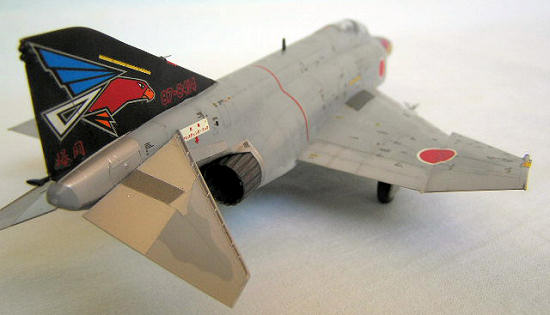 as the
ASM-1 antiship missile, and the Mk 82 and JM-117 modified with the GCS-1 laser
guidance kit, though you would rarely if ever see this loads in pictures.
Indigenous AAMs were also tested, like the AAM-3 (kind of AIM-9X) and the AAM-4
(equivalent to the -120), but only the first one is seen in pictures.
Maneuvering slats were ruled out because of the cost. The conversion is probably
not so radical as, say, Greek Peace Icarus 2000 or German F-4F ICE Phantoms, but
the increment in capability is substantive.
as the
ASM-1 antiship missile, and the Mk 82 and JM-117 modified with the GCS-1 laser
guidance kit, though you would rarely if ever see this loads in pictures.
Indigenous AAMs were also tested, like the AAM-3 (kind of AIM-9X) and the AAM-4
(equivalent to the -120), but only the first one is seen in pictures.
Maneuvering slats were ruled out because of the cost. The conversion is probably
not so radical as, say, Greek Peace Icarus 2000 or German F-4F ICE Phantoms, but
the increment in capability is substantive.
Ninety-six out of the surviving 125 -4EJs were upgraded. Seventeen of the remaining were adapted to recce role under the designation RF-4EJ Kai (not to be confused with the RF-4Es!) These machines display the same airframe as the -4EJ Kai, with same armament capability, exception made of the cannon (though the fairing is in place!), and an AN/APQ-172 radar. They are devoid of any internal recce equipment, but they can carry a large Mitsubishi ELINT pod on the center line pylon. They are usually confused for fighter models in picture captions (see some of the sources quoted to believe!) Best bet to identify them in a picture is looking for the typical Japanese tactical recce camouflages and the “Woodpecker” insignia of the 501st Hikotai on the tail.
| THE KIT |
The Hase family of 1/72nd Phantoms are fine kits, though their “multimould” nature makes them a careful build. I especially like the separate intake plate, cockpit, seats (though both need a PE set), and surface detail. Decals, in this case for 301st and 302nd Sqn. machines in gaudy (and gaudier!) schemes, are first rate, though a bit thick. Armament is absolutely absent, and should be sourced from somewhere else; in this case, an AAM-3 taken from the Hasegawa JASDF weapons set. Not using any PE set, I threw in two Quickboost seats.
| CONSTRUCTION |
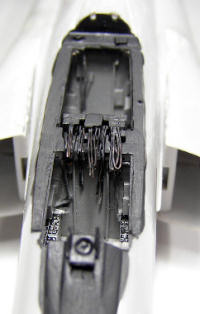 This
model was actually built for a friend of mine, an Aussie diplomat colleague here
at Nairobi, so I planned it from the start as a “desktop” model, i.e., to be
displayed at his office desk on a permanent base under a display case, and
possibly subjected to non-specialized cleaning and caring. Therefore, I ruled
out opened canopies, and chose to simplify undersurfaces detailing.
This
model was actually built for a friend of mine, an Aussie diplomat colleague here
at Nairobi, so I planned it from the start as a “desktop” model, i.e., to be
displayed at his office desk on a permanent base under a display case, and
possibly subjected to non-specialized cleaning and caring. Therefore, I ruled
out opened canopies, and chose to simplify undersurfaces detailing.
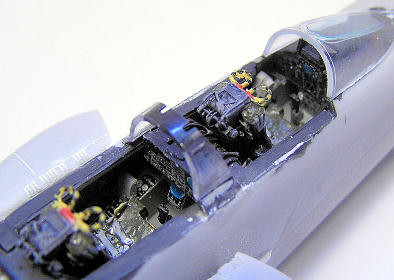 Interior
went first, building up the sidewalls and HUD from scratch; however, I chose to
use the kit’s decals for the instrument panels and consoles, though I strongly
suspect that they show the normal EJ dashboards; under a closed hood they look
just fine. I added the prominent throttle levers and a lot of cables and
electrical boxes. I also added the tiny reinforcement strips at the nose radome,
a Kai feature the manufacturer chose to miss (the actual radome in E model kits
is a separate part, so they could have moulded a specific one for the Kai).
Interior
went first, building up the sidewalls and HUD from scratch; however, I chose to
use the kit’s decals for the instrument panels and consoles, though I strongly
suspect that they show the normal EJ dashboards; under a closed hood they look
just fine. I added the prominent throttle levers and a lot of cables and
electrical boxes. I also added the tiny reinforcement strips at the nose radome,
a Kai feature the manufacturer chose to miss (the actual radome in E model kits
is a separate part, so they could have moulded a specific one for the Kai).
Airframe construction
was as expected, a bit cumbersome because of the many parts in which it is built
up from, but that’s model building, I guess. I am a poor assembler who relies
more in putty and sandpaper than in proper dry fitting and aligning of the
parts, and that approach really doesn’t work that well in these kits. However,
the model was eventually assembled, corrected, primed and preshaded.
| COLORS & MARKINGS |
Painting
After decades wearing the bland Air Defense scheme
of FS 16440/White, JASDF Phantoms have blossomed out in many interesting
camouflage schemes, sometimes made even gorgeous with Air Combat Meet special
paintings. This machine displays
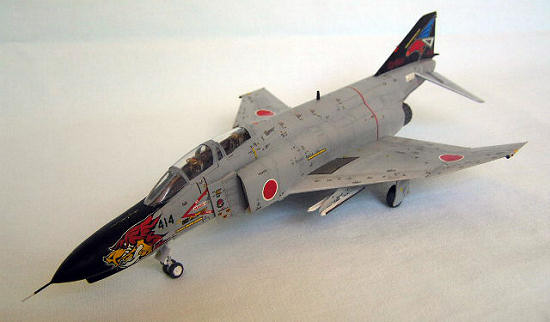 a kind of
“Ghost” scheme in FS 36320/36375 with the extraordinary 302nd
“Kandinsky Eagle” on the tail and the head of a… dragon?... on the nose. The
camo was painted in WEMMs colors with hard liquid masks, which look fine in this
scale, if you do not overstress the separation lines between the colours, in
mottle fashion over the preshading, giving a realistic “dirty” look. The amazing
retouching over the panel lines was made by simply hand brushing them in a mix
including 35237, then sanding them a little and overspraying them lightly in
36320 for blending. It worked. Exhaust areas and cans were painted in Alclad
Aluminium and Magnesium, with MM Gun Metal and a dry-brush of Greys and Tans on
the cans themselves. The interior of these received the usual “petals” made of
Tamiya tape, an easy trick which looks invariably good.
a kind of
“Ghost” scheme in FS 36320/36375 with the extraordinary 302nd
“Kandinsky Eagle” on the tail and the head of a… dragon?... on the nose. The
camo was painted in WEMMs colors with hard liquid masks, which look fine in this
scale, if you do not overstress the separation lines between the colours, in
mottle fashion over the preshading, giving a realistic “dirty” look. The amazing
retouching over the panel lines was made by simply hand brushing them in a mix
including 35237, then sanding them a little and overspraying them lightly in
36320 for blending. It worked. Exhaust areas and cans were painted in Alclad
Aluminium and Magnesium, with MM Gun Metal and a dry-brush of Greys and Tans on
the cans themselves. The interior of these received the usual “petals” made of
Tamiya tape, an easy trick which looks invariably good.
Decals
Kit’s decals are high quality if a bit thick, but this would not show under a displaying case. Stencils are mercifully bunched together in a most sensible way, relieving the modelers of many hours of sweating, though that means more carrier film to show silvering. No decal solutions were used, everything was made to set by the “hot flannel” trick.
| FINAL CONSTRUCTION |
Having the canopies
closed and fitted from the start meant an uneventful final construction, these
being most difficult parts to align. I added the landing gear, gear doors (the
angle of the front one is subjected to suspicion) and the armament: the
F-15-style central tank, painted 36118 (actually Panzer Grey) and th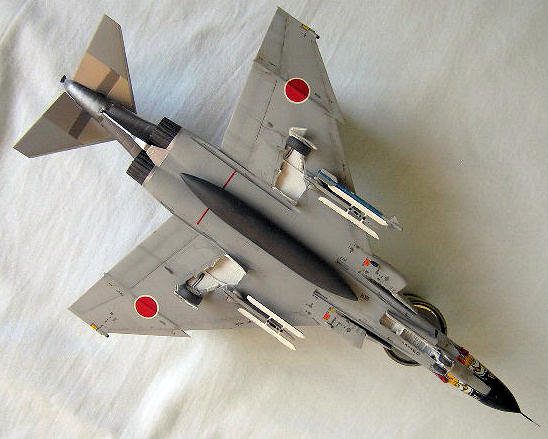 e
AAM-3 painted as a training round.
e
AAM-3 painted as a training round.
Having used Xtracrilix varnishes as topcoats, the model was safely washed in a very thinned MM Raw Umber and Black, and that was it. No postshading of any kind.
| CONCLUSIONS |
Not a weekend project, and certainly a gruesome
sight at some stages of the construction, as a finished product the Hasegawa
1/72nd Phantoms always look good.
This one certainly tired me a little, but I can still recommend them and shall
surely build a couple more.
| REFERENCES |
-
A. Baugher website
(wonderful historical data)
-
The Mc Donnell
Douglas F-4 Phantom II, Part 3: Overseas Operators”, Andy Evans, SAM
Publications (mainly a source of pictures, including this very machine).
-
Koku Fan magazine
(being in Japanese language, this was of little help except for pictures, again
including this machine)
-
Tamiya magazine
If you would like your product reviewed fairly and fairly quickly, please contact the editor or see other details in the Note to Contributors.